When brands complain about influencer platforms, they rarely say, “I need more charts.” What you see instead, is a pattern of dashboards that are too powerful, too expensive, and still not answering the question the CMO actually asks:
“Which creators drove revenue, and can we prove it?”
Advanced analytics has become both the key differentiator and the biggest source of friction. Smaller teams feel priced out of enterprise stacks that promise AI-driven ROI but bury them in features they’ll never use, while global brands wrestle with data that doesn’t quite match native social metrics, inconsistent EMV formulas, and gaps wherever creators refuse to authenticate their accounts.
This article is for marketers who are done buying vanity dashboards. You’ll see each platform evaluated through the lens of real pain points: data accuracy and coverage, how well analytics connect to ecommerce and CRM revenue, whether the UI is usable for lean teams, and how easily insights can be exported into the way your organization already reports performance. The goal isn’t just to find “the most advanced” tool—it’s to find the platform whose analytics will actually change how you brief creators, allocate budget, and justify influencer spend to the rest of the business.
1. Brandwatch Influencer Marketing Software


Key Features: Global Influencer Payment, Influencer Discovery, Influencer directory management, Creation of private influencer network, Campaign management and reporting, Broad platform coverage, Automated reporting,
Channels: YouTube, Facebook, Instagram, Twitter, Twitch, TikTok, Shopify
2. Traackr
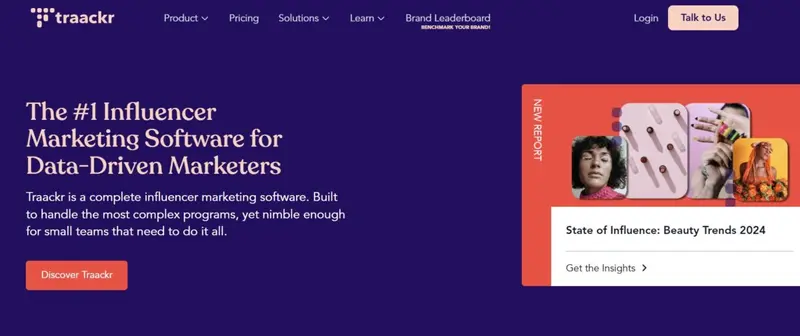
Best for: Mid-sized and enterprise brands and agencies running multi-market, performance-driven influencer programs
Notable clients: Global brands in beauty, fashion, CPG, tech, and luxury
Locations: HQ in San Francisco, with offices in Boston, New York, London, and Paris
Traackr positions itself as a full-stack influencer marketing system of record built for data-driven marketers rather than one-off campaign tools. It combines influencer discovery, relationship management, campaign execution, and global governance, but the real value for this short-list is its analytics spine. The platform is used in 80 countries and 19 languages and underpins programs for some of the largest advertisers in the world, which means every brand that plugs into it benefits from a mature, benchmarkable data environment.
From a buyer’s perspective, Traackr sits closer to a performance and decision-intelligence layer for creator marketing than a simple workflow tool. It’s designed to answer questions like “Where is my budget actually working?” and “How does my creator program stack up against the category?”
Advanced analytics & measurement
Traackr’s analytics revolve around one core idea: you need a single, robust KPI to understand influencer impact across platforms and markets. That’s where the Brand Vitality Score (VIT) comes in. VIT combines three dimensions—visibility (reach), impact (weighted engagement), and trust (how focused content is on your brand)—into one normalized metric that works across YouTube, TikTok, Instagram, and other channels.
VIT isn’t just a fancy score; it’s wired into how the platform diagnoses performance. The framework breaks results into four levers:
- Creator volume – how many creators are mentioning your brand
- Frequency – how often they post about you
- Audience size – reach per mention
- Content performance – VIT generated per 1,000 followers
This lets you see whether you’re underperforming because you don’t have enough creators, the wrong tier mix, weak content, or a misaligned posting cadence.
On top of that, Traackr tracks classic campaign metrics—posts, impressions, views, engagements, engagement rate—and couples them with spend-efficiency metrics like CPP, CPM, CPV, CPE and CPC. That’s where it moves from “reporting” to “media optimization”: you can quickly see which creators, formats, and networks are generating the best economics, not just the loudest vanity numbers.
For brands operating in competitive categories, the leaderboards and benchmarking tools are a major differentiator. Monthly beauty and fashion leaderboards rank thousands of brands by VIT across key geos and expose additional indicators such as activated influencers, posting frequency, average audience size, and VIT rate. This effectively turns your analytics into a category-level dashboard—you can see who’s winning attention, how they’re doing it, and where white-space might exist.
Traackr also goes beyond campaign views by enabling:
- Real-time monitoring of hashtags, mentions, and content across major platforms
- Conversion and revenue tracking via links and promo codes for social commerce and affiliate programs
- Data-lake / BI integrations so influencer data can be joined with sales, CRM, or web analytics for deeper modeling and MMM inputs
For teams that need to socialize results, reporting is exportable into slide-ready views. Benchmarks, VIT, spend metrics, and creator-level performance can be pulled into decks without rebuilding charts manually every month.
Case example & strategic impact
In practice, the analytics have had material impact for large brands. One global CPG company cut influencer campaign costs by 40% after centralizing program data and agency collaboration within Traackr. With a shared system of record and standardized metrics, they could see which creators and markets were driving real impact and re-allocate budget accordingly, instead of relying on fragmented agency reports and EMV estimates.
Another dermo-cosmetics group used Traackr’s performance and benchmarking data to pivot away from a reliance on big-name creators and toward smaller, more relevant voices in the acne category, which helped them grow in a crowded market.
These examples are representative of how the platform is meant to be used: as a feedback loop for strategic decisions—tier mix, channel mix, budget allocation—rather than simply a place to log posts.
Best Fit For:
For senior marketers who need more than surface-level dashboards, Traackr is one of the strongest options in this lineup:
Strengths:
- Deep, standardized KPI framework (VIT) that’s actually usable for cross-platform and cross-brand comparisons
- Robust spend-efficiency and ROI tooling that ties creator activity to cost and, where tracked, to conversions
- Category-level benchmarks and leaderboards that put your numbers in context
- Integrations and data-lake options for teams that want influencer data inside their broader analytics stackWatch-outs:
- The richness of the data can make the platform feel heavyweight; smaller teams may need enablement time to get full value
- User reviews note occasional slowness and data freshness issues, which matters if you rely heavily on real-time optimization

Key Features: Search/Discovery, Influencer Relationship Management, Team Collaboration Tools, Campaign Management, Campaign Reporting, Influencer Analysis, Audience Analysis, Product/Gifting Tools, Forms and Compliance, Fake Follower/Fraud Detection, Competitor Research,
Channels: Facebook, Twitter, Instagram, YouTube, Pinterest, Tumblr, Blogs
3. Upfluence
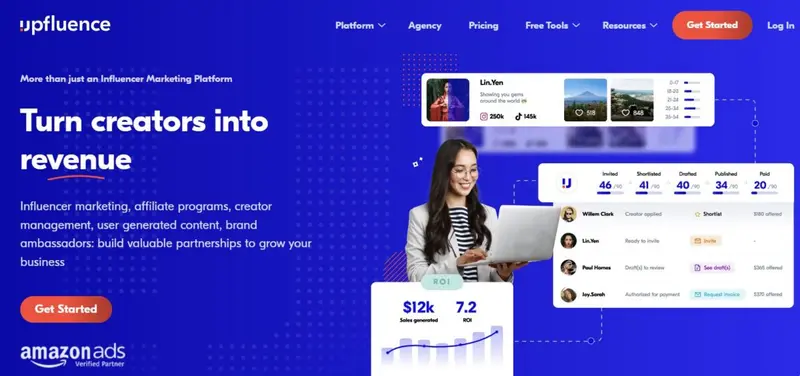
Best for: Ecommerce and DTC brands, and agencies that need hard revenue attribution and scalable affiliate/creator programs.
Notable clients: Amazon, Marriott, Asics, Universal Pictures, OMEGA, Mercedes-Benz, HP, Shiseido, Herman Miller and more.
Locations: New York (HQ), Los Angeles, Lyon, Mexico City.
Upfluence is built around one idea: influencer and affiliate campaigns should be measured like performance marketing, not PR. The platform combines influencer discovery, campaign workflow, and payments with a revenue-first analytics layer that ties every creator and piece of content back to sales. Ecommerce integrations with Shopify, WooCommerce, Magento, BigCommerce and Amazon sit at the core of the product, so you can ingest order data, generate trackable discount codes and affiliate links, and see creator-driven revenue directly inside the dashboard.
It’s less about brand-lift studies and more about showing which creators actually move inventory.
Advanced analytics and measurement
This is where Upfluence earns its place in an “advanced analytics” shortlist.
1. Revenue & ROI tracking tied to each influencer
Upfluence lets you generate customized discount codes and affiliate links per creator, then maps every sale back to those identifiers. You can break down sales by influencer and by campaign, with metrics like revenue, number of orders, commissions, average order value (AOV), and ROI for each partner.
Dashboards show total clicks and conversions, click-to-sale conversion rates, and cost per acquisition so you can evaluate creators like any other paid channel.
2. Campaign-level performance views
Performance data rolls up into campaign dashboards where you can see:
- Total revenue and ROI per campaign
- Aggregated clicks, conversions and effective CTR
- Performance by channel and media type
- Top- and bottom-performing creators ranked by revenue, orders or engagement
This makes it straightforward to answer exec-level questions like “Which campaigns drove the most profit?” or “Which creator cohort is worth scaling?”
3. Social performance & engagement analytics
On the social side, Upfluence builds data-rich influencer profiles that track follower counts, historical post performance, engagement metrics (likes, comments, views), and engagement rates across Instagram, TikTok, YouTube, X/Twitter, Twitch and more.
Free audit tools (Instagram, TikTok, YouTube, Twitter, Pinterest) mirror what’s inside the paid product: they surface engagement, growth and basic audience stats, and help flag fake followers or low-quality accounts before you commit budget.
4. Audience & fraud-risk indicators
For authorized Instagram profiles, Upfluence exposes audience demographics such as age, gender and location, as well as percentage of real vs fake followers and estimated fees. These signals give marketers a quick quality check on audience fit and authenticity.
5. Ecommerce & affiliate analytics
Upfluence’s integrations with Shopify, WooCommerce, Magento, BigCommerce and Amazon unlock deeper funnels:
- Auto-generated coupon codes per creator with tracked sales
- Affiliate performance metrics (clicks, conversions, sales, commissions)
- Amazon Attribution integration to link creator content to Amazon store revenue
This gives ecommerce teams a single source of truth across DTC and marketplaces.
6. Granular, iterative optimization
The platform is built for iterative testing. You can track how individual creator metrics evolve over time, compare cohorts, and see which tactics (content format, offer type, posting cadence) correlate with higher revenue or ROI. The UI is structured to highlight top performers and under-performers so you can double down, pause, or renegotiate based on data, not gut feel.
Case snapshot: affiliate program with 10x ROI
One dietary supplement brand integrated its Shopify store with Upfluence, built an affiliate program, and used the platform’s analytics to track individual creator results. Over five months they generated more than $440K in sales, averaging over $3K in daily revenue and a 10x return for every dollar spent. This was driven by granular ROI tracking at campaign and influencer level, with real-time reports guiding which partners to renew and which to drop.
This kind of case is typical of how Upfluence is positioned: creator programs are treated as a measurable revenue channel, with performance reports you can confidently take into a CFO meeting.
Strategic approach & fit for advanced-analytics buyers
For a marketer specifically hunting for advanced analytics, Upfluence is strongest when:
- Sales attribution matters more than vanity metrics. The platform excels at tying posts and creators to transactions, not just impressions.
- You’re running always-on affiliate or ambassador programs. Long-term cohorts benefit from the longitudinal tracking, iterative testing, and cohort-level ROI views.
- You’re deep in ecommerce. Native integrations and promo-code workflows reduce manual reconciliation between your store, spreadsheets, and marketing reports.

Key Features: Influencer Search & Discovery, Relationship Management, Campaign Management, Third Party Analytics, Automated Recruiting, Influencer Lifecycle Management, Team Collaboration Tools, Content Review, Campaign Reporting, Audience Analysis, E-commerce Tools, Product/Gifting Tools, Payment Processing, Social Listening, Affiliate Management, Affiliate Campaigns,
Channels: Instagram, Youtube, Facebook, Twitch, Tiktok, Twitter, Pinterest, Blogs
4. CreatorIQ
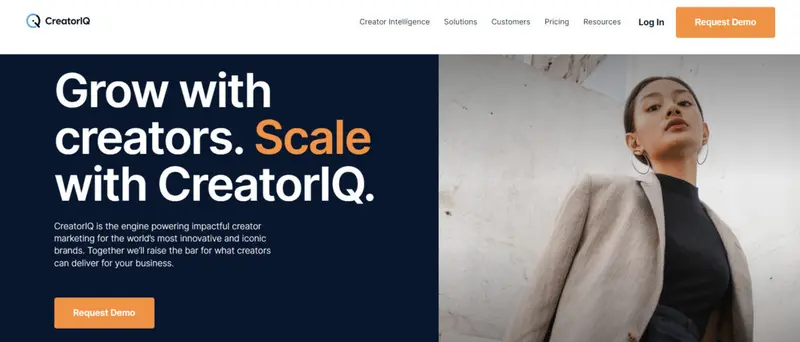
Best for: Large, multi-market brands and agencies that need enterprise-grade measurement, benchmarking, and governance for creator programs
Notable clients: Nestlé, Unilever, CVS, Google, Sephora, Delta, YETI, Dentsu Creative, Moose Toys, Beiersdorf, iHeartMedia
Location: Culver City, California, United States
CreatorIQ positions itself as an AI-native operating system for creator-led growth, with measurement and analytics sitting at the center of the platform. Built on “The Creator Graph,” it pulls real-time data from all major social platforms and ties it into customizable dashboards, benchmarking tools, and attribution workflows so teams can prove ROI and optimize global creator programs rather than just individual campaigns.
Advanced Analytics & Measurement Capabilities
CreatorIQ’s biggest differentiator is its analytics spine. For advanced analytics, this is where it actually earns the label.
First, the platform treats benchmarking as a product, not a side-chart. Its global benchmarking engine is built on a large dataset of creator and brand activity across major networks, so you can see how your programs stack up by industry, region, creator tier, and platform. Instead of looking at your own engagement or reach in a vacuum, you’re comparing against realistic category baselines—crucial when you need to explain whether a campaign was merely “good for you” or genuinely top-quartile.
Second, CreatorIQ goes deep on content, engagement, and exposure quality, not just volume. Reports break performance down at post level using metrics like views, comments, shares, and engagement rates, then layer in reach and impression modeling. When creators authenticate, you get actual reach and impression data via platform APIs; when they don’t, CreatorIQ uses models trained on a large pool of authenticated accounts to estimate exposure per platform. That mix lets you make apples-to-apples comparisons across creators and campaigns without being held hostage by who connected their account.
Third, its Earned Media Value and potency analytics turn social “buzz” into a dollar-denominated signal leadership can understand. EMV, EMV per creator (potency), and sponsored EMV let you quantify how much value your creator community is generating versus what you’d likely pay for equivalent paid media. Over time, that becomes a powerful lens for questions like which creators consistently punch above their weight, which product lines get the strongest lift, and how your investment profile compares to peers.
On the performance side, CreatorIQ’s conversion tracking and attribution layer makes creator data usable in the same conversations as paid social and affiliate. The platform can mass-generate tracking links, automatically apply your UTM structure, and push link performance into your broader analytics stack. That means you’re not just reporting on engagement and EMV—you can see which creators, posts, and formats are actually driving sign-ups, add-to-carts, or revenue, and adjust budget mid-flight.
Because all of this happens on top of rich audience and fraud analytics, the numbers you’re optimizing against are less likely to be inflated. You can filter and segment creators by audience location, age, gender, and engagement characteristics, while authenticity and brand-safety checks flag suspicious patterns or risky content histories. That makes it easier to defend why you backed a specific set of creators in a particular market and to avoid paying for reach that’s either fake or off-brand.
CreatorIQ also pulls paid, organic, and UGC performance into a single view, so teams can see how different content types interact. You’re able to measure how organic creator posts, whitelisted ads, and spontaneously generated UGC each contribute to reach, EMV, and conversions instead of treating them as separate, unconnected streams. For brands leaning into creator-powered paid media, that holistic lens is essential for budget allocation.
Finally, the platform is built to plug into an enterprise analytics ecosystem rather than sit off to the side. Data APIs and integrations with BI tools and marketing stacks mean you can pipe CreatorIQ metrics into existing dashboards, MMM models, or executive reports. For advanced teams, that turns creator data from a marketing vanity layer into another input in serious performance and forecasting conversations.
Taken together, these capabilities make CreatorIQ one of the few platforms that genuinely supports program-level decision-making—benchmarking, attribution, and optimization across markets and tiers—rather than just post-by-post reporting.
Case Study: DiGiorno Pizza’s TikTok Measurement
DiGiorno, a Nestlé brand, partnered with Reach Agency on its “DiGiorno Made Us Do It” TikTok campaign aimed at Gen Z. The team needed a reliable way to quantify the initiative’s impact beyond vanity metrics. CreatorIQ’s end-to-end platform was used to monitor and optimize the campaign, ultimately contributing to a 6.8% improvement in consumer attitudes toward the brand. creatoriq.com
For a CMO or head of social, the value here is clear: TikTok creator content can be linked back to attitudinal lift and program KPIs instead of just views, and those insights can be reused as benchmarks for future creative, creator tiers, and investment levels.
Strategic Fit for “Advanced Analytics” Buyers
CreatorIQ is best suited to enterprise and upper mid-market teams that:
- Run always-on, multi-region creator programs and need to standardize measurement across markets and business units.
- Care about benchmarks, competitive context, and EMV, not just basic influencer KPIs.
- Want tight integration with BI, ecommerce, and affiliate stacks so creator performance can be analyzed alongside paid, CRM, and sales data.
If your primary selection criteria for an influencer marketing platform are rigorous measurement, benchmarking, and attribution—and you have the scale to justify an enterprise platform—CreatorIQ is one of the strongest analytics-first choices in this category.

Key Features: Search/Discovery, Automated Recruiting, Influencer Relationship Management, Content Review, Campaign Management, Campaign Reporting, Influencer Analysis, Audience Analysis, E-commerce Tools, Product/Gifting Tools, Forms and Compliance, Fake Follower/Fraud Detection, Payment Processing,
Channels: Facebook, Instagram, Twitter, YouTube, Pinterest, Twitch, Blogs
5. Klear
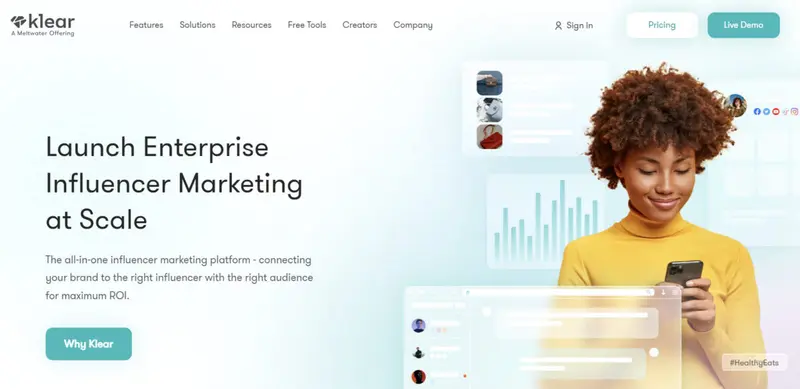
Best for: Data-driven brands and agencies that care about audience quality, benchmarking, and ROI more than vanity metrics.
Notable clients: Chobani, Sephora, and other global consumer brands.
Location: Tel Aviv–Yafo (HQ) with offices in New York and San Francisco.
Klear started as a pure analytics product and it still feels like it. It’s an influencer marketing platform where the data layer leads: AI-driven discovery, dense audience insights, and campaign measurement sit at the center, with workflows layered around them. The platform maps millions of creators across Instagram, TikTok, YouTube, X, Facebook, Twitch and blogs, and categorizes them into more than 60,000 topic areas, across 6,000+ languages and 195 countries.
Klear belongs in the segment that treats creators as a quantified media channel: audience composition, authenticity, and EMV are first-class objects, not nice-to-have add-ons.
Advanced analytics & measurement
This is where Klear is strongest, and why it makes sense in an analytics-led shortlist.
1. True Reach: modeled, fraud-aware exposure
Klear’s signature metric is True Reach—a machine-learning estimate of how many real people an influencer actually reaches per post. It analyses long-term audience and engagement patterns and discounts fake followers, inactive users, and people who never engage. Separate True Reach models are used for Instagram posts and Stories, and extend across Facebook, X and Twitch.
For unauthenticated accounts, True Reach fills the gaps where first-party impression data isn’t available, giving you a more realistic exposure baseline to plan against.
2. Full-funnel, multi-network campaign metrics
Klear’s campaign layer tracks a consistent metric set across all major networks:
- Posts per platform (IG posts & Stories, Facebook posts & Stories, TikTok, YouTube, Pinterest, X, Twitch, blogs)
- Engagements (likes, comments, shares, replies, taps back, reposts, depending on channel)
- Engagement rate, normalized by follower base
- Reach / views, either from first-party data (for authenticated profiles) or True Reach models
- Estimated Media Value (EMV) per platform, rolling up into campaign-level value
This gives you a clean cross-channel view of how a campaign actually performs, not just on one network.
3. Conversions, coupon codes, and ROI estimation
Inside campaign reports, Klear separates conversions via tracking links from conversions via coupon codes, so you can see exactly which mechanism drove revenue.
On top of that, its ROI features use EMV and conversion data to estimate the equivalent paid media cost at both macro (whole campaign) and micro (creator or post) levels. That lets you benchmark influencer spend against your media buying and negotiate rates using hard numbers rather than generic “rate cards.”
4. Measure tab: Overview vs deep analysis
The Measure section splits into an Overview tab for high-level KPIs and an Analyze tab for deeper exploration. You can drill into:
- Engagement metrics (likes, comments, shares, replies)
- Conversions and sales tied to specific links or codes
- Content specifics (formats, posts, Stories, platforms)
It’s designed to answer both “How did we do?” and “What, specifically, drove that result?” in the same place.
5. Audience, demographic & psychographic analytics
Where many tools stop at age/gender/location, Klear leans heavily into audience quality and psychographics:
- In-depth demographics (age, gender, geography) plus interests, brand affinities and online behaviors.
- Topic classification into 60k+ niches, enabling truly granular market and interest analysis.
- Authenticity and audience-quality indicators to help avoid inflated or botted audiences.
This is particularly valuable if your brief is less “find fitness creators” and more “find creators who reliably move product among wellness-obsessed millennial parents in specific markets.”
6. Benchmarking, overlap & competitive intelligence
Klear supports industry benchmarking, audience overlap, and competitive analysis:
- Benchmark your campaign KPIs and audience quality against your category and key competitors
- Map audience overlap between influencers to avoid paying multiple creators for the same eyeballs and to structure more efficient reach plans
- Use competitive features to understand how others in your space deploy creators and content formats, then position your own program accordingly
7. Real-time monitoring & interactive analytics
Powered by Meltwater’s infrastructure, Klear pushes instant updates when creators post and offers interactive analytics that refresh in near real-time. You can see engagement, reach and conversions evolve during the campaign rather than waiting for end-of-flight reporting, and the platform layers in AI-driven suggestions for optimization.
Reports are ready-to-export and can be white-labeled, which is handy if you’re an agency compiling decks for clients.
Case snapshot: Sephora’s data-driven uplift
A major beauty retailer used Klear’s campaign-measurement suite to monitor engagement, reach, and conversions across a portfolio of creators and content formats. By running iterative optimizations based on those metrics—scaling top-performing creators, adjusting formats, and reallocating budget—they reported a 15% increase in sales from influencer activity and up to a 30% uplift in ROI attributed to Klear’s AI-driven prediction and measurement tools.
For a senior marketer, this is exactly the kind of analytics story you want: clear attribution, repeatable insights, and a link between creator decisions and commercial outcomes.
Strategic fit for advanced-analytics buyers
Klear is best suited to teams that:
- Need deep audience and authenticity analytics to de-risk creator selection.
- Want benchmarking and overlap analysis to engineer efficient reach and avoid waste.
- Care about modeled, fraud-aware reach metrics (True Reach) and EMV-based ROI alongside conversions, not just basic impressions.
- Run programs where real-time monitoring and client-ready reports matter—especially agencies and global consumer brands.
If your primary selection criteria are audience intelligence, robust campaign measurement, and the ability to argue for or against creator investment using hard numbers, Klear is one of the cleanest analytics-first choices in the influencer platform landscape.

Key Features: Search/Discovery, Automated Recruiting, Influencer Relationship Management, Influencer Marketplace, Content Review, Content Library, Campaign Management, Campaign Reporting, Influencer Analysis, Audience Analysis, E-commerce Tools, Product/Gifting Tools, Forms and Compliance, Fake Follower/Fraud Detection, Payment Processing, Social Listening, Competitor Research, Visual Discovery,
Channels: Instagram, YouTube, TikTok
6. Aspire (formerly AspireIQ)
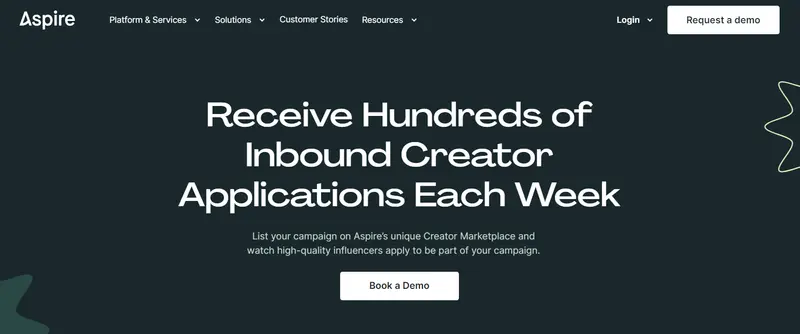
Best for: Mid-to-large ecommerce and DTC brands that care about full-funnel, revenue-level analytics
Notable clients: Samsung, M&M’s, Dyson, HelloFresh, Walmart, Kettle & Fire, Outer
Location: Headquarters in Austin, Texas, United States
Aspire (formerly AspireIQ) positions itself as an all-in-one word-of-mouth commerce platform, built for brands that want influencer, affiliate, ambassador, and UGC programs running from a single environment. The core modules—discovery, creator marketplace, campaign management, affiliate tracking, reporting & analytics, and content management—are tightly connected, which matters when your main question is “What’s actually driving revenue?” rather than “How many posts went live this month?”
Advanced Analytics & Measurement Capabilities
Aspire’s analytics are structured around full-funnel visibility. Reporting dashboards track everything from upper-funnel signals (impressions, social reactions, engagement rate) to lower-funnel outcomes (conversions, revenue, sales, ROAS and Total Media Value) for each campaign in a single view. Graphs and summary tiles are designed to answer the executive-level question—“Did it work?”—without needing to rebuild charts manually in another tool.
The Impact Dashboard pulls this into program-level intelligence. It shows a snapshot of the last six months across four funnels—Content, Impressions, Engagement, and Sales—plus month-over-month trends, with the option to slice data by different variables. That lets you see not just whether a single activation performed, but how content volume, reach, and revenue are moving across your entire program.
A standout feature for advanced teams is Aspire’s Total Media Value (TMV) metric. TMV assigns explicit dollar values to actions like impressions, views, likes, comments, and clicks across formats such as Instagram posts, Stories, and Reels, then rolls them into a single number representing what equivalent paid media would have cost. Because the calculation is built on engagement quality, TMV doubles as a signal for influencer pricing and fraud control—creators with genuine, engaged audiences generate higher TMV, while inflated or bot-heavy accounts lag behind.
On the commerce side, Aspire’s analytics are tightly coupled with Shopify-based sales tracking. Brands can bulk-generate unique promo codes and affiliate links per influencer directly inside the platform, sync them to Shopify, and have redemptions pulled back automatically—no additional pixels or manual reconciliation required. The result is precise attribution for lower-funnel performance: you can see which creators, offers, and campaigns drive sales and higher average order values, and you can scale incentives or commission tiers based on real revenue data rather than vanity metrics.
Paid amplification and UGC get their own measurement layer via the Ads Dashboard, which gives a consolidated view of creator-powered ad performance, including top-line metrics like ad spend, sales generated, and ROAS for UGC ads. High-level widgets highlight what’s working so you know where to drill down and where to cut.
Underneath this sits creator-level performance analytics. Aspire’s Social Analytics and campaign reporting track the performance of individual creators week over week, helping brands identify reliable performers and underperformers across platforms. Brand testimonials highlight the ability to see creator stats directly via Aspire’s integrations as a “game changer” when managing large, always-on programs.
For teams obsessed with ROI, Aspire combines affiliate analytics and fraud controls: affiliate dashboards track link and code performance, surface top-performing partners, and include controls to block suspicious conversions. Third-party analysts also point to UTM-based conversion monitoring and ROI dashboards as key strengths, which makes it easier to align Aspire data with your broader acquisition and ecommerce reporting. And for brands that want to marry social impact with site analytics, Aspire explicitly encourages pairing its dashboards with Google Analytics to build a complete attribution picture across sessions, revenue, and LTV.
Results & Use Cases
Case studies and customer stories point to Aspire’s analytics driving tangible outcomes: sub-$5 CPMs, $0.17 CPE, and multi-year programs that generate millions of engagements and a 2,100% increase in affiliate sales for brands like Outer. Program owners frequently call out the value of seeing engagement, sales, and creator performance in one place rather than jumping between spreadsheets, Shopify, ad accounts, and social native analytics.
Strategic Fit
Aspire is best suited to brands that treat influencer and creator programs as a revenue channel rather than a purely awareness play. If you’re running structured, multi-campaign programs—especially in ecommerce—its combination of full-funnel dashboards, TMV, Shopify-native sales tracking, affiliate analytics, and UGC ad reporting gives you enough data to defend budgets and systematically reallocate spend toward what actually works.
For a CMO or growth lead reading “Best influencer marketing platforms with advanced analytics,” Aspire stands out as a platform that can credibly answer both sides of the equation: how your creator ecosystem is performing at the content and community level, and how that performance translates into revenue, ROAS, and long-term program value.

Key Features: Search/Discovery, Influencer Relationship Management, Influencer Marketplace, Team Collaboration Tools, Content Review, Content Library, Campaign Management, Campaign Reporting, E-commerce Tools, Product/Gifting Tools, Forms and Compliance, Payment Processing, Social Listening, Competitor Research, Visual Discovery, Influencer Content Amplification,
Channels: Instagram, YouTube, Facebook, Twitter, Pinterest, Blogs
Conclusion
The real differentiators show up in the frustrations brands mention last: analytics that break down in niche or local-language markets, dashboards you can’t customize to match internal KPIs, and “advanced” exports that still require rebuilding every slide manually. Add the friction of creators refusing authentication, data silos across TikTok–Instagram–YouTube, and attribution models that collapse into last-click, and it’s clear why teams feel trapped between feature bloat and limited real-world visibility. The strongest platforms are the ones that solve these gaps, not the ones promising the most metrics.



